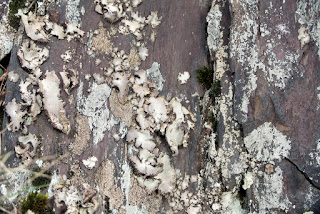Our planned destination was the top of the Long Mynd in an area known as High Park. When we got there, although it was dry and sunny, the westerly wind was ferocious. Clearly another day like the previous Wednesday when shelter from the wind was paramount.
A Plan B was needed. A map was consulted to find a suitable spot on the east which ought to be sheltered from the gale. Ashes Hollow was selected as the replacement.
This required us to retrace our steps to All Stretton along a single track road where earlier I had a minor "incident" with the driver of a white Audi.
I was driving up the single track road when the white Audi was coming down. As we could not pass on the road we both stopped. The driver of the white Audi waved at me to get out of the way. To my left was a small ditch and then a bank covered in bracken. So I shrugged and gestured to the other driver to pull onto the leveller grassland to the Audi's left.
The response of the other driver was to start coming forward clearly with no intention of moving onto the grass. The only option for me, other than not moving, was to go onto the grass on my right and go round the advancing car.
Forgive me for being old-fashioned but I thought that a person coming down a hill gave way to one coming up and we pass on the left!
Rant over.
We made it to the road leading to Ashes Hollow with only one more incident when the three cars we were travelling in met a car coming up the hill from All Stretton. We dutifully pulled in but confusion reigned as the other car also pulled in and waited. We took the hint and drove past. Clearly I am old-fashioned.
Unfortunately when we got to Ashes Hollow there was nowhere to park.
Plan C was initiated and we went to Cardingmill Valley where there is lots of parking.
As we drove up the road to the car park we passed several coaches which should have warned us about what we going to see.
There is a stream that runs down Cardingmill Valley. In and around this stream along most of the length of it that we passed there were hundreds of school children with tape measures and survey poles recording things on clipboards.
Fortunately most of the photographs we took did not capture the children's activities just our own.
 |
| Photograph: Bob Kemp |
 |
| Photograph: Nigel Cane-Honeysett |
I used the term "early find" very loosely in the above statement. Our false starts meant that it was almost lunchtime when we started.
Lunch was soon taken.
After lunch two spiders of abundance at the opposite ends of the scale were photographed. The abundant Araneus diadematus which you may well find in your garden:
 |
| Photograph: Nigel Cane-Honeysett |
 |
| Photograph: Nigel Cane-Honeysett |
 |
| Photograph: David Williams |
 |
| Photograph: David Williams |
 |
| Photograph: David Williams |
 |
| Photograph: David Williams |
 |
| Photograph: Bob Kemp |
 |
| Photograph: Bob Kemp |
The trouble with steeply inclined surfaces is that you need to be able to clamber up to them.
And then you need to get down again. Not so easy at our age. Sometimes you need to revert to childhood and slide down.
But once down you can smile with relief and pose for the camera.
 |
| Photograph: Bob Kemp |
True lover's knot (what a splendid name);
 |
| Photograph: Nigel Cane-Honeysett |
 |
| Photograph: David Williams |
 |
| Photograph: Nigel Cane-Honeysett |
It started well.
But we soon had to step aside as a party of children were coming down the path. We were very patient. After waiting and waiting as they all passed we set off again on the ascent. Eventually we got within sight of the waterfall but it was like Trafalgar Square on a busy day of demonstrations.
We took one look then turned back.
On the way down a speculative beating of a gorse bush dislodged a Heather ladybird.
 |
| Photograph: David Williams |
As we walked back to the cars the sun was getting lower in the sky bathing the hills in a wonderful golden light.
 |
| Photograph: David Williams |
My thanks to the National Trust for giving us permission to survey, although, technically, they thought we would be around High Park! My thanks also to the photographers David Williams, Bob Kemp and Nigel Cane-Honeysett for allowing me to use the efforts of their labours in this report.





























A tale of perseverance and great finds!
ReplyDelete